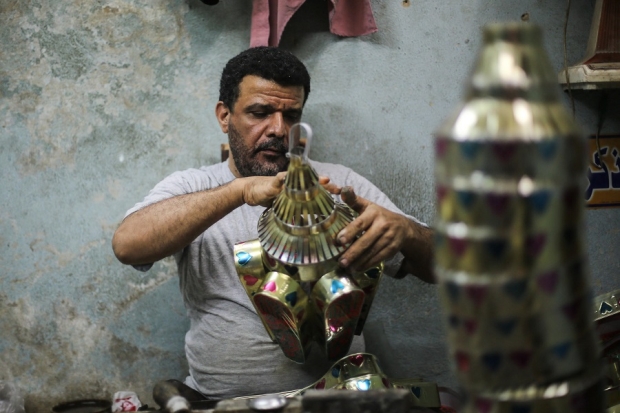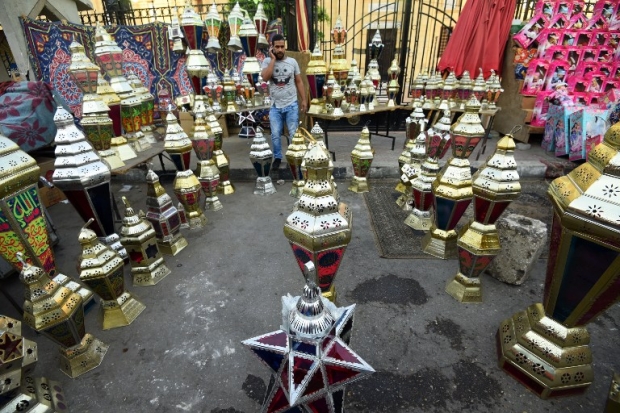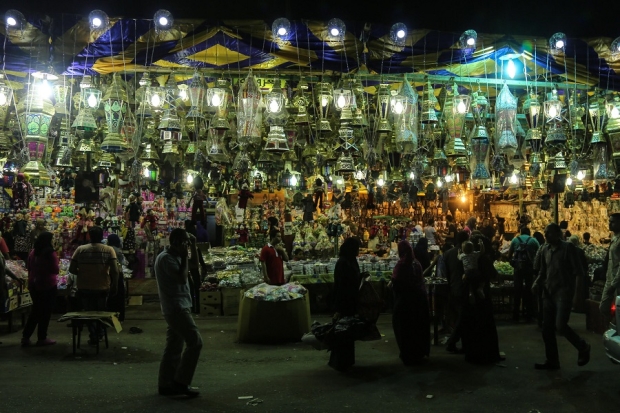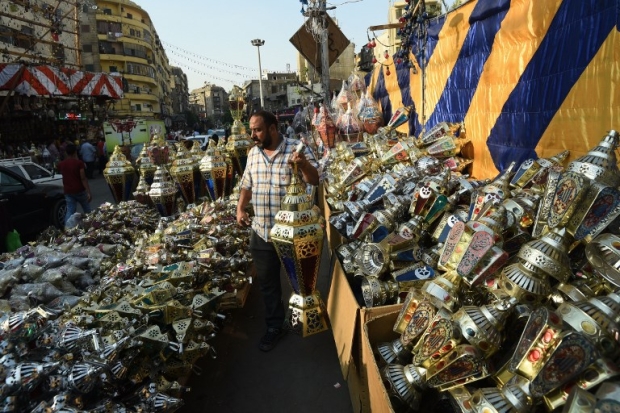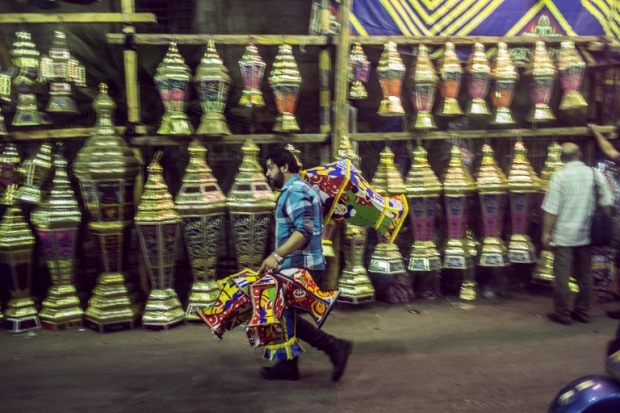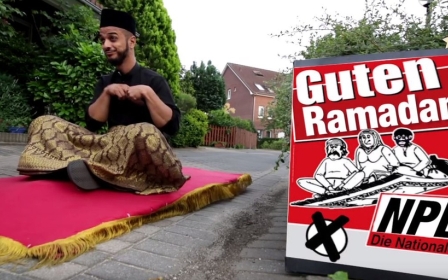Egypt's Ramadan lanterns struggle to light up dark nights

CAIRO - Colourful lanterns and glistening metal material are piled up around Nasser Mostafa, as he sits cross-legged on the floor of his humble workshop.
In Cairo's working class district of Sayeda Zeinab, the melodies of legendary Egyptian singer Umm Kulthum accompany Mostafa's crafting of a traditional Ramadan lantern known as a fanoos. As flames tremble and melt the metal, he conscientiously carves the ornate Ramadan staple of Egyptian households.
Mostafa has been in the industry of making Ramadan lanterns since 1990. The 48-year-old now runs the same workshop where he had been employed for over 20 years.
‘Last year I used to produce thousands [of lanterns], but this year I have reduced my work by 75 percent'
- Nasser Mostafa, owns shop of Ramadan lanterns
“Last year I used to produce thousands [of lanterns], but this year I have reduced my work by 75 percent. I used to have three and sometimes four labourers, but now I narrowed them down to one,” he said.
The materials used for making lanterns include tinplate, glass and varnish. Everything is imported by Egypt except for glass, which has not escaped the hike in prices either.
“The youngest and least experienced labourer would work for a wage ranging from EGP 100 ($5.53) to 150 ($8.3) per day,” said Mostafa.
“From where would I afford that? And how would I be able to feed my family?” he added.
Mostafa produces his lanterns in batches of 100. Producing small-sized lanterns takes two days to finish, while big-sized lanterns can take from one to two weeks.
This year, Mostafa says that the sales of his workshop have dropped by 70 percent.
'How would I be able to feed my family?'
-Nasser Mostafa, owns shop of Ramadan lanterns
For a small profit between EGP3 to 5 (16 to 27 US cents), Mostafa sells his average-sized handmade lanterns for around EGP 45 ($2.49) per piece, up from last year’s price of EGP27 ($1.49).
Prices for big lanterns used mostly to decorate homes, balconies and building entrances range from EGP100 ($5.53) to 400 ($22.22), depending on their design and the material used to make them.
This was part of an economic reform package linked to a $12bn International Monetary Fund loan.
Important tradition
The traditional lanterns called fawanees are an essential part of celebrating the month of Ramadan every year in Egypt.
The origins of the ornate lanterns date back to Egypt’s Fatimid dynasty. Children proudly flaunt their new lanterns, while singing famous Ramadan jingles.
The higher prices were a shock to Fouad's mother. Yet despite the hike, she disgruntledly bought a lantern for almost double what she paid last year.
'Prices have doubled but my family, including kids and adults, believe the new lantern respresents the happiness and joy of Ramadan, we can't pass a Ramadan without buying a lantern'
-Mother
"Prices have doubled but my family, including kids and adults, believe the new lanternrepresentss the happiness and joy of Ramadan. We can't pass a Ramadan without buying a lantern," Fouad's mother said.
As an alternative to Egyptian-produced lanterns, some customers prefer to purchase Chinese-made lanterns, claiming that they are less expensive and safer for children to play with. Due to strict regulations on imports, however, the number of Chinese lanterns has dwindled in the market.
“The Egyptian tin-made lanterns are often lined with very sharp edges, and also susceptible to rusting in the long run,” said Heba Mohamed, a mother of three.
“They’re mere toys that sing and dance, maybe they’re more appealing to buyers because of that,” he said.
In the past, Chinese-made lanterns were a strong competitor to the locally produced ones, but in 2015, Egypt's Ministry of Industry and Trade issued a rare decree banning imports of Chinese-made lanterns and other traditional Egyptian handicrafts. The idea was to give local products a boost.
In December 2016, customs increased by up to 60 percent on 364 products, incurring a big price rise mostly on food.
'The US dollar still hasn’t settled in its fair position against the Egyptian pouns, nor close to the rates expected at the time of free float,”
-Omar El-Shenety, managing director of the regional investment bank Multiples Group
Shenety expects the rate of the dollar to decline slightly after Ramadan, since many Egyptians have changed their currency to perform Umrah (pilgrimage) in Mecca during Ramadan. He added that as the summer kicks in, many Egyptians working abroad travel to Egypt to spend time with friends and family, increasing the supply of dollars in the country.
“Obviously things are taking more time than expected. Yes, we have combated the black market, however, the US dollar still hasn’t settled in its fair position against the Egyptian pound, nor close to the rates expected at the time of free float,” said Shenety.
Shenety and other economic experts expected the dollar to settle at around EGP13 to 14 ($0.71 to 0.77) after six months, but it still stands at over EGP18.
Shenety conceded that inflation would still be there next year, adding. “However, with a slightly reduced rate since there won’t be that much accumulation as a result of the market shock like what happened this year.”
Yet many Egyptians like Mostafa cannot afford to wait for the economic situation to improve. Typical favourites are unaffordable, he said.
“Can anyone this year even go near the dry fruits of Ramadan? The kilogram of dry dates was for EGP6 (33 cents) and 10 (55 cents) last Ramadan, today it’s for EGP30 ($1.65) and 35 ($1.93),” Mostafa said.
“We have been patient for the last three years. In fact, we have been patient for longer than that, but then what happened?”
This article is available in French on Middle East Eye French edition.
New MEE newsletter: Jerusalem Dispatch
Sign up to get the latest insights and analysis on Israel-Palestine, alongside Turkey Unpacked and other MEE newsletters
Middle East Eye delivers independent and unrivalled coverage and analysis of the Middle East, North Africa and beyond. To learn more about republishing this content and the associated fees, please fill out this form. More about MEE can be found here.


